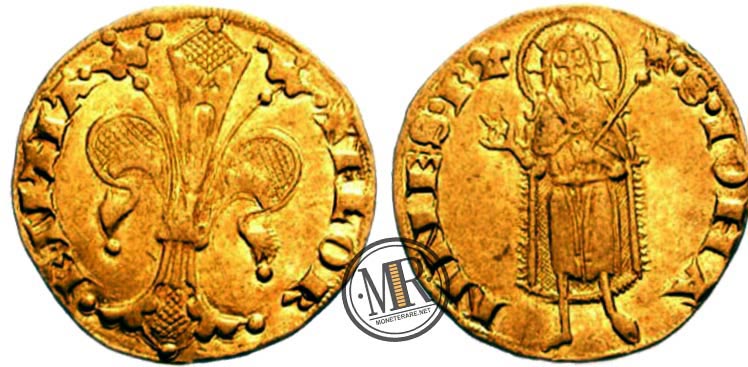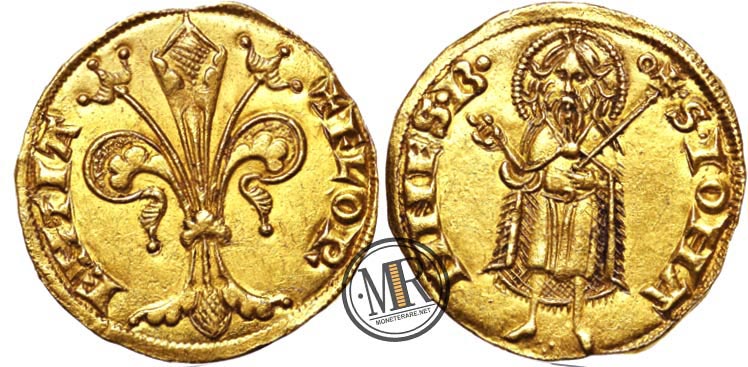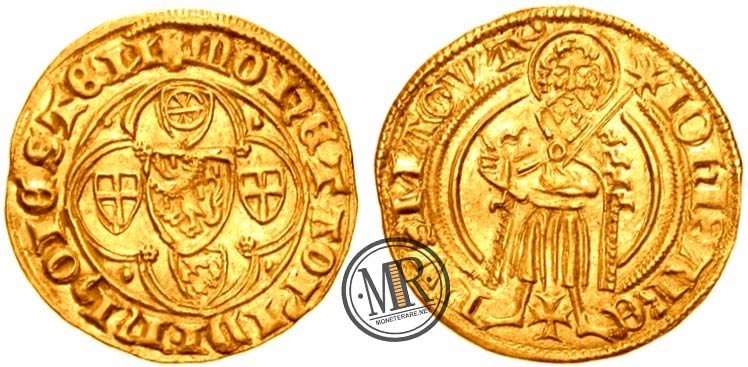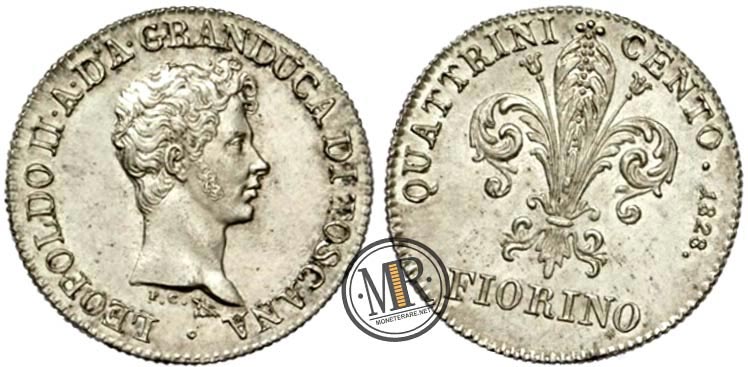The gold Florin coin, is a famous gold coin of ancient times. It has ancient origins that must be sought in the thirteenth century, in the middle of the Middle Ages.
Origins of the name Florin
The name of this gold coin was given to it because of the lily flower represented on the obverse of the coin. Florin is the translation of the italian “Fiorino” that means “little flower”.
Gold Florin Coin of Florence
The first gold Florin coin was minted in Florence in the 13th century, when it was still the “Republic of Florence”.
From 1215 began the first disagreements between Guelphs and Ghibellines that finally led to the birth of the “Republic of the First People” in 1250. In this Republic the milites had been removed from the leadership of the government, entrusted instead to merchants, craftsmen, bankers, notaries and judges (the “People”).
In that period the Government of the First People wanted to bet on the resourcefulness and business spirit of its merchants and bankers and in 1252 was minted for the first time the gold coin that will take the name of Fiorino.
Gold coins were no longer minted since the fall of the Roman Empire. But in 1252 both Florence and Genoa, resumed to mint gold coins (respectively the Fiorino and Genovino).
Description of the 1252 Gold Florin Coin
The Gold Florin of 1252 is composed of pure 24-carat gold. It has a diameter of 20-21 millimeters and a weight ranging from 3.46 to 3.53 grams.
Its very high purchasing power made necessary the adoption of several submultiples such as the Silver Florin (“Grosso” or “Popolino”, corresponding to about 1/20 of Gold Florin) and many other coins.
On the obverse of the Golden Florin of 1252 stands a large flower of Giglio, surrounded by the inscription “FLOR ENTI”.
On the reverse is represented St. John, patron saint of the city.
The Saint is standing, with a smooth nimbus (aureole) and wearing a cloth tunic and a fringed fur cloak, closed at the chest by a button.
With his right hand he blesses while with his left hand he holds, resting on his shoulder, a long rod with a cross at the top. The inscription reads “- S IOH NNES – B – “.

It is classified of rarity R3 , that is it is considered a very rare coin. In 2008, at an auction, a gold coin of this first issue was sold for 3304 €.
After 1252 were minted other versions of the original coin called “first series”. The Gold Florin 2th series, minted since 1252, differs from the 1th for the nimbus (the halo) of San Giovanni, which in this coin is pearled and not smooth.

Value of the Golden Florin of Florence
It is classified as R2 , a very rare currency, and can reach a value of over one thousand euros. At an auction in 2007 an exemplar of this Gold Forint “II series” was sold for 1121 euro.
There are numerous “series”, coined over the years until 1533.
Inside each series then, starting from the third one, there are different coins according to the different symbols, referred to the initials of the mintman, added between the feet of the Saint or in the legend.
If you have similar coins or some other piece you want to sell individually or in lots, you can rely on the partner we always use to buy or sell coins online: click here to open his site. (registration and item listing are free).
Hungarian Florin Coin
From 1325 came into use, in Hungary under Carlo Roberto D’Angò, a gold coin weighing about 3.40 grams, like the Florin of Florence, which immediately became one of the most important coins of that region.
Initially, given the obvious similarity with the Florence coin, it was called florentinus, which later became forint. In Italy the Hungarian Florinus was called “Ongaro“, and was imitated by many Italian mints.
Generally there was represented a warrior with wide breeches, that’s why they were also called Ongari bragoni.
To the present day the Hungarian currency is the Magyar forint (or Hungarian forint), despite Hungary’s accession to the European Union, which has been in place since 1994, and despite being (since 2007) in the Schengen area.
The Rhenish Gold Florin Coin
Known as Gulden, the Rhine Florin is the gold coin that circulated in the Holy Roman Empire between the 14th and 15th centuries.
Charles IV of Luxembourg, as a reward for their support in his ascent to the throne of the Holy Roman Empire, granted the bishop electors of Mainz, Trier and Cologne the privilege of being able to mint gold coins.

Looking at this beautiful rare coin up close. On the obverse, in this Rhine Florin of John II of Nassau, Archbishop of Mainz (1397-1419), you can see St. John standing with nimbus, cloak, cross of St. John and the legend IOH IS AREPVS MAGVT.
Instead, on the reverse side, the shields of the principalities of Mainz, Trier, Cologne and Bavaria are inserted in a four-leaf clover. In the center of the four-leaf clover are the arms of Nassau.
The Double Leopard or UK English Gold Florin
This gold coin was minted in England under King Edward III who was based on the Florin of Florence. This rare coin was minted from 1344 but it remained in circulation very little and was soon withdrawn.

For this reason, of this one that is considered by many to be one of the most beautiful medieval English coins, few examples have survived.
On the obverse is represented the king, sitting on the throne under a canopy, with the symbols of power and two leopards sitting on the sides, from which the name “double leopard” derives.
The inscriptions to the obverse read “EDWR D GRA REX ANGL Z FRANC DNS HIB. The meaning is “Edward by the Grace of God King of England and France, Lord of Ireland”.
On the reverse side is the royal cross, with a leopard and a four-leaf clover in each quarter and the inscription “IHC TRANSIENS PER MEDIUM ILLORUM IBAT (Christ was passing among them)”.
Silver Florin Coin of the Grand Duchy of Tuscany
When in 1824 Leopold II of Hapsburg-Lorraine came to power in Tuscany, he decided to introduce a new coin, the Florin coin of course (Fiorino).
This, however, was a silver coin, whose value corresponded to that of 100 Quattrini.

On the obverse is represented the profile of Leopold II, while on the reverse the flower of “Giglio di Firenze” and the value corresponding to one hundred Quattrini.
Leopoldo II abdicated, in 1859, in favor of the Provisional Government of Tuscany. This governing body coined a new version of the florin with a lion facing left holding an Italian flag.
A website that we always recommend to sell and buy Italian coins but also coin from all over the world is this website (click to open it).

The Dutch Florin Coin
When in the XIII century Florence began to mint florins, these quickly imposed in the commercial exchanges, so much to bring also the Netherlands to adopt in the XV century the Dutch Forint (Nederlandse gulden) as currency.
In Holland the Forint remained the official currency until it was gradually replaced by the Euro in 1999. Some former Dutch colonies have kept it as official currency.
This is the case of the Dutch Antilles, which still retains the Dutch Antilles Florin of the Netherlands Antilles, and the Island of Aruba, detached from the Netherlands Antilles but which retains the Aruban Florin as its currency.
We hope this article has been of interest to you. In this case we would like you to leave a positive vote below (stars) or a comment on the article. If you want to continue reading more interesting gold coins we recommend you to consult the articles we suggest below.
Other Gold coins that might interest you:
